Radeon RX 590 Review: AMD’s First 12nm GPU Hits 225W
Why you can trust Tom's Hardware
Temperatures, Clock Rates, and Infrared Measurements
Although the card’s clock rates on an open test bench look good, they break down once we install XFX's Radeon RX 590 Fatboy 8GB OC+ in a closed case. Our charts make it easy to see the connection between frequency and temperature in a real-world gaming sequence and FurMark.
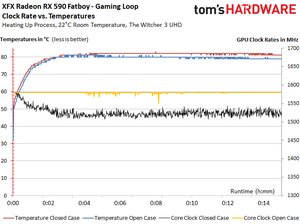
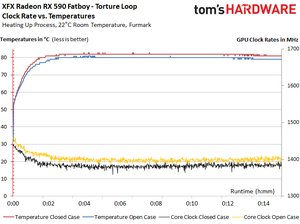
For the power consumption we measured, XFX’s cooler really does seem to be a limiting factor. Something larger (and quieter) would have certainly helped. To be sure, a constant 1580 MHz is only possible in a really well-ventilated case.
Here’s what our results look like in table form:
| Header Cell - Column 0 | Initial Value | Final Value |
|---|---|---|
| Open Test Bench | ||
| GPU Temperature | 32°C | 80°C |
| GPU Clock Rate | 1580 MHz | 1580 MHz |
| Room Temperature | 22°C | 22°C |
| Closed Case | ||
| GPU Temperature | 33°C | 82-83°C |
| GPU Clock Rate | 1580 MHz | 1527 MHz |
| Temperature Inside of Case | 25°C | 45°C |
The following images include infrared measurements from our gaming and FurMark loops, both on an open test bench and in a closed case. Differences between the two environments are readily apparent, especially since the cooler is operating at its upper limit.
Temperatures During Gaming
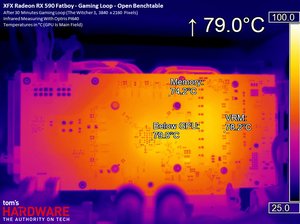

Temperatures During FurMark
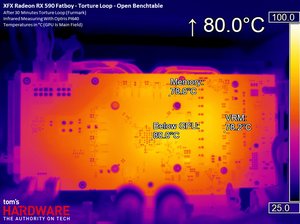
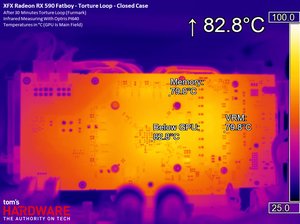
MORE: Best Graphics Cards
MORE: Desktop GPU Performance Hierarchy Table
MORE: All Graphics Content
Get Tom's Hardware's best news and in-depth reviews, straight to your inbox.
Current page: Temperatures, Clock Rates, and Infrared Measurements
Prev Page Power Consumption Next Page Fans and Noise